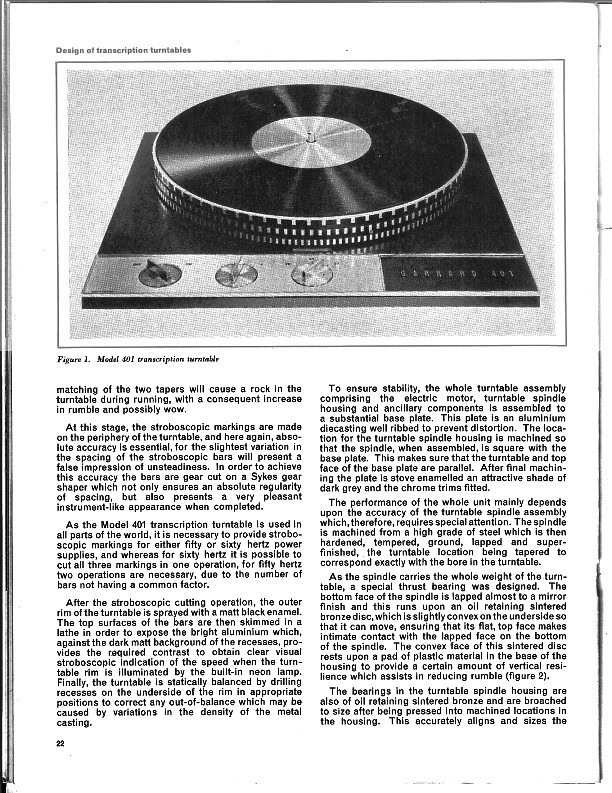I posted this material on Dominic's Garrard forum...may as well do so here, too.
=======================================================
In the early 1960s, Garrard's Chief Engineer E.W. Mortimer wrote two articles for the in-house
magazine of the Plessey Group, which then was owner of Garrard. The first one was entitled,
"Design of Transcription Turntables" and used as its basis the Garrard 401.
This article has been published on various websites before; I've posted it here. Wish they were
a bit larger, easier to read; these are not my scans.
Mr. Mortimer also wrote another article for Plessey about Garrard. It is the last half of this post.
UPDATE, January 2015:Since the original post nearly three years ago, I was able to obtain a better scan of the
Transcription Turntables article (HOORAY!) but much of the advantage would have been lost in
conversion to image format and upload.
However, you can download the PDF from my Mediafire account:
http://www.mediafire.com/view/l4dxmkc14naa2f1/E.W.Mortimer_Design_of_Transcription_Turntables.pdfOr from my MEGA account:
https://mega.co.nz/#!0BEgCQhA!t-HOeWffG27lzQfoOaesy_UTWU1-EdNm7mlnaP_QTzA




------------------------------------------------------------------------------------------------------------------
In the early 1960s, Garrard Chief Engineer E.W. Mortimer wrote two articles for the in-house magazine of the Plessey Group about Garrard, a Plessey subsidiary at the time. While his first article, "Design of Transcription Turntables" is probably better known among today's Garrard enthusiasts, it represented the "prestige" end of the Garrard operation, which (according to some) was operated at a loss from the days of the Garrard 301, to establish and maintain Garrard's status as a quality brand. Some say that even the high-end automatic turntables Lab 80 and Type A didn't really earn that much money for Garrard; the great bulk of the company's profits were from the sales of mass-produced, popular-priced record changers.
In 1960, the lower-priced record changers RC210 and RC209 were discontinued. Their successor, the Autoslim chassis, was far simpler and less costly to build, while offering a higher level of performance, modern styling, and greater convenience too. Quickly the small-platter Autoslim itself was joined by an upscale sibling for the hi-fi market, originally dubbed "Autoslim DeLuxe" and then renamed "AT6" with the "AT" signifying "Automatic Turntable" as it joined the Type A, which was then enjoying very high sales volume as "the first Automatic Turntable." The Autoslim chassis was seen in everything from low-priced radiograms to upper/midline high fidelity component systems; as a record changer the ultimate Garrard was the SL65, an Autoslim chassis with synchronous motor, cast aluminium platter, counterweighted tonearm, and the ability to play all size records mixed in a single stack, as long as they were all the same speed. The Autoslim chassis was also used to build the famous and very popular SP25 series hi-fi single record players.
The Autoslim chassis was responsible for the great success of Garrard at the company's peak. It had originated from Garrard itself, under Mr. Mortimer's leadership. Cheaper, clunkier designs done later under Plessey were what doomed the company and caused its precipitous decline.
Mr. Mortimer gave this much bigger part of the Garrard operation its due, in an article for Plessey entitled, "Automatic Record Changer Production Techniques."
These scans are from a copy of the article, sent to me by Mr. Mortimer himself in response to an inquiry I sent to Garrard in Swindon.








